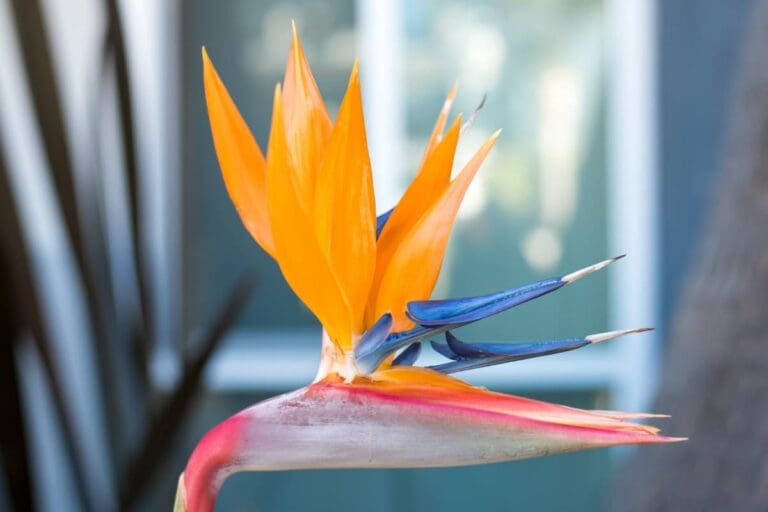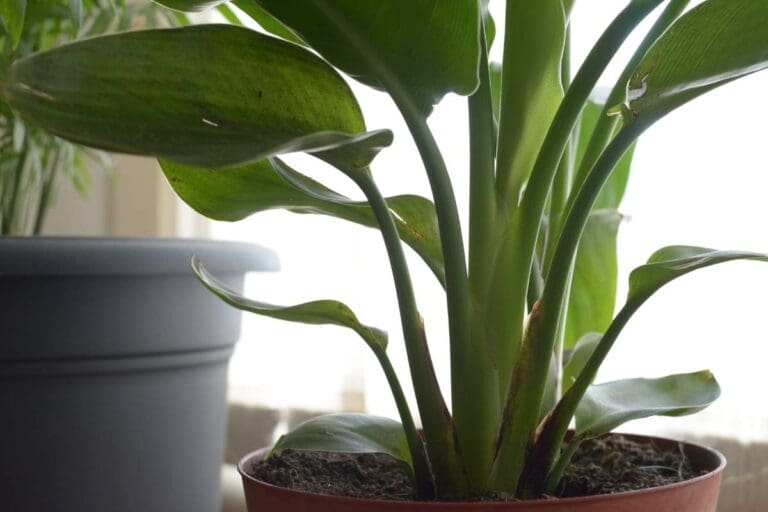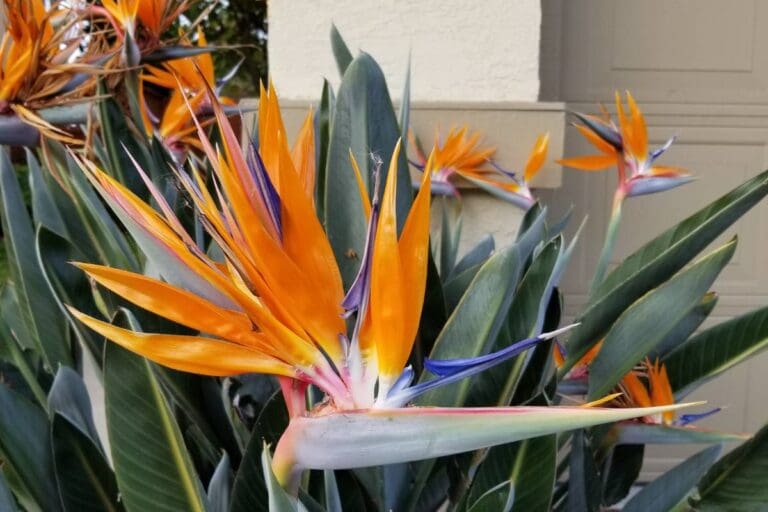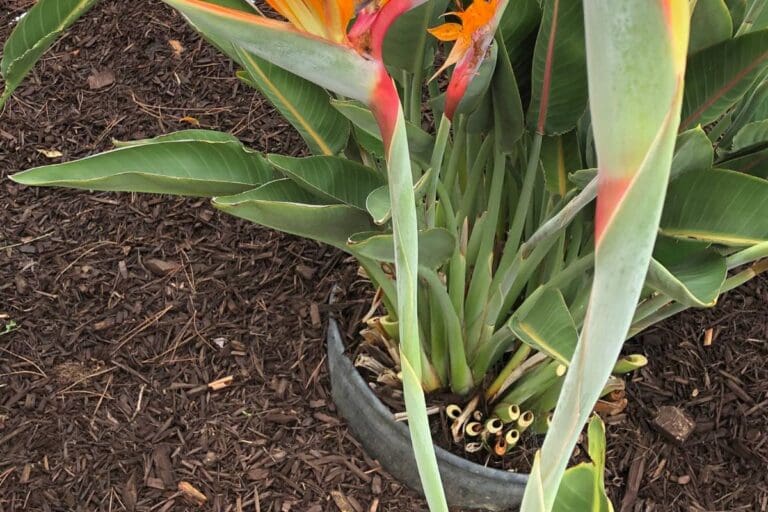Why Is My Bird of Paradise Drooping? (14 Causes+Fix)
Bird of Paradise, a South African native species, is a sheer treat to the eyes when it comes to beauty, and lucky are those who have them in their homes or gardens. But witnessing a droopy Strelitzia is a matter of concern.
Generally, Birds of Paradise start to droop when they are underwatered or kept in inappropriate humidity or temperatures above 85°F. Other causes of droopy leaves include root rot due to overwatering and pests and diseases. To fix the problem, provide adequate watering and humidity to the plant.
However, this is a common problem many Bird of Paradise growers face. You only need to figure out the exact cause and approach the remedy.
Besides treating the problem, you must also understand the preventive measures to stop any future issues with your plant. I will take you through the effective ways to treat your bird of paradise and take good care.

Please note: Simplify Plants is reader-supported. Some links in the post are affiliate links and I get a commission from purchases made through links in the post.
Common Reasons for Bird of Paradise drooping
Whenever there is an issue with your plant, remember there is always more than one possibility.
Your paradise bird might be drooping for any of the following reasons.
1. Lack of sufficient light
Sunlight is one of the fundamental conditions that a plant needs for its growth.
Being a tropical species, this plant requires a well-lit spot.
In their native environment, they prefer to grow under bright light for at least 5-8 hours a day.
Keeping this plant in a shadowy location will hinder its natural photosynthesis rate and compromise its growth.
Moreover, cooler shadow spots reduce the transpiration rate and prevent water absorption from the soil.
This ultimately leads to loss of turgor pressure and the plant droops.
2. Overwatering
Overwatering single-handedly can ruin the health of a plant in no time.
One of my friends had a bitter experience with the Bird of Paradise.
After witnessing droopy leaves during the summer months, he misunderstood the actual cause and thought it to be dryness.
He poured excess water and ended up killing the plant.
Later, the plant was found to have root rot due to frequent watering and damp soil.
If you don’t want to witness such a consequence, keep a check on watering.
It is a widespread issue that causes droopy leaves and hampers the plant’s overall growth by weakening the root system.
Damp soil works as a breeding ground for microbes that cause several diseases. Moreover, wet soil aids in fungal growth.
3. Underwatering

Don’t eliminate the fact that underwatering can lead to drooping in your favorite Strelitzia.
Leaving your plant in dry soil for too long or skipping the regular water schedule during the growing season or summer months can pull out excess water from the plant body through transpiration.
Extreme water loss can cause irreversible damage as it decreases the turgor pressure.
The stem, along with the leaves, will hang downwards limply.
If this continues for too long, the plant can die due to dehydration.
Plants can also experience drooping during winter when the weather is dry.
Proper protection is needed, as regular watering during cold times is not preferable.
4. High temperatures or extremely cold
Tropical species are more likely to prefer moderate temperatures, which tend to be warm.
The foliage of Strelitzia starts to droop whenever the ambient temperature falls below 65°F.
If kept at a lower temperature for too long, the physiological functions get disrupted, and the plant will ultimately collapse.
Frost and cold drafts are extremely harmful to this plant as they cause tissue damage by destroying the cell walls.
Freezing temperature leads to the formation of ice crystals inside plant cells that prevent living cells from functioning properly.
Besides the extreme cold, a temperature above 85°F is not ideal for this plant.
I have experienced damage in my bird of Paradise from exposing them to extreme heat, especially during summer months.
Hot drafts drain moisture from the leaves.
As the foliage loses water faster, they become more prone to dehydration and ultimate loss of turgor pressure.
5. Low level of humidity

Keeping the plant in low humidity affects its health similarly caused by underwatering and dryness.
Tropics are known to have high moisture levels throughout the year.
And surroundings with high humidity that closely replicate tropical environments work best for Strelitzia.
The plant will lose more water through its stomata if the air is too dry.
Even soil tends to lose more water through evaporation in a dryer climate.
The foliage will become droopy, dry, and crisp if you don’t check properly.
Restraining the well watering schedule will cause dehydration, and the plant will soon die off.
Winters are infamous for most of such damage as the air remains too dry.
Even after providing proper care, my neighbor lost their entire Birds of Paradise collection.
They explained this was due to over-dryness as the plants were kept in the open air during winter.
In the beginning, they witnessed the yellowing of leaves, and soon the leaf margin started to turn brown.
These are the basic symptoms for identifying the root cause.
6. Drooping after repotting
For most plants, repotting or changing the soil mix can exert stress or shock to the species.
If you have recently repotted or transplanted your bird of paradise, you are more likely to experience droop in your plant.
The plant reduces its physiological functions to adapt to the new environment whenever transplantation or reporting is applied.
This sometimes involves slowing down of absorption rate by the root system, ultimately decreasing the turgor pressure.
This phenomenon is common even when you bring a new plant to your collection.
Repotting often causes damage to the plant.
This can also be a reason for showing signs like droop or limpness.
7. Water quality
While examining the potent causes for the drooping of your favorite birds of Paradise, you may miss an uncommon yet significantly valid factor to investigate: the water quality you have been using for your plant.
You heard us right. Maintaining an appropriate watering schedule with inappropriate water can harm the plant severely.
Tap water is high in active chlorine and fluoride components.
Strelitzia is sensitive to these compounds, as those chemicals destroy chlorophyll and cause the browning of the leaves.
Such leaves die off soon, and the foliage collapses in no time.
The chemical accumulates in the soil mix and disrupts respiration, photosynthesis, and the distribution of proper nutrients in the plant.
8. Nutrient deficiency

This tropical native is an extensive feeder.
They need a steady nutrient supply, especially during their growing phase.
Failing to provide that will make the plant unhealthy and appear in symptoms like droopy foliage.
Plant leaves lose their rigidity mostly due to magnesium deficiency.
Besides drooping, you may witness discoloration.
9. Pest infestation
Strelitzia is not very susceptible to pest infestation.
They can be a breeding ground for a few parasites if kept in unhealthy conditions.
Sap-feeding insects like aphids, scales, mealybugs, and spider mites suck nutrient-rich sap from their leaves and stems.
This drains moisture from the plant making the leaves droopy and wilted.
After feeding on its sap, aphids excrete a sticky substance, known as honeydew, on the plant’s leaves.
This attracts more infectious pathogens like gnats to breed on the leaf surface.
Fungal growth damages the leaves from the core.
10. Diseases
In many instances, a lack of one or a few growth factors can invite several diseases in birds of Paradise.
Common diseases include root rot and stem rot due to damp soil and wilt from bacterial infection.
These health issues affect the plant in a somewhat similar manner by causing tissue damage, mostly in the root system.
The plant cannot absorb water from the soil and ultimately loses its rigidity from the top.
Leaf blight is another common disorder seen in this plant due to overwatering.
It appears initially as random white spots on the leaves and eventually causes droop to the entire foliage.
11. Inappropriate container

Keeping the plant in a relatively small pot can make it rootbound.
It suffocates the plant as a root system does not get sufficient room for its growth.
Root-bound plants do not get sufficient nutrients.
Nutrient deficiency and insufficient space ultimately lead to health hazards like drooping leaves and stunted growth.
12. Inappropriate root development
One of my friends explained how improper root development causes limpness in the foliage.
This can happen due to many reasons.
Some potent causes, he explained, were hypothermia, root rot, and chemical stress.
Owning a nursery, he encountered many such events where plants, even after getting routine care, developed signs of stunted growth like droopy leaves and wilting.
After investigating thoroughly, he found out most of these plants either suffer root damage due to some underlying cause or improper root development due to unhealthy soil mix or smaller containers.
This reduced the plant’s ability to absorb water and nutrients from the soil and generated pressure to export growth factors to the leaves.
This deficiency makes the leaves weak, and they droop.
13. Misapplication of fertilizers
Fertilizers are an essential part of Strelitzia’s growth.
But the incorrect application of chemical manure can bring great risk.
Excess fertilization leads to chemical build-up in the soil.
High concentrations of these harmful chemicals destroy roots’ ability to absorb water.
These components start to accumulate in the plant’s body and cause toxicity.
When applied directly to the leaves, fertilizers can block the pores (stomata) on the leaf surface, preventing them to transpirate.
Leaves turn brown, dry, and droop due to chemical burns and low turgor pressure.
14. Aging of the leaves

Birds of Paradise are tropical evergreen plants, meaning they keep their leaves longer than deciduous varieties.
With time, some of the leaves start showing visible signs of aging.
This can appear in the form of discoloration or splits.
As a leaf turns old, it loses rigidity and starts to droop.
This is a natural phenomenon, and there is nothing to worry about.
But if you witness drooping in most leaves, eliminate the chance of aging and investigate the real cause before it becomes too late.
Now that you have already understood and found out the key reason behind your drooping Strelitzia, it’s time for you to work on the remedies.
We are here with some of the simplest yet effective ways to treat your plant.
How to revive your bird of paradise from drooping?
Now that you know all the possible reasons that can lead to drooping leaves in your bird of paradise, here are a few ways to revive the plant and bring it back to health.
- If the problem is with low light, the best way to deal with it is to choose a well-lit spot with direct sunlight for your plant. For indoor species, keep the plant near sunny windows. For outdoor species, you can keep your plants under the porch where they get shelter from excess summer heat yet can absorb direct sunlight. You can even use artificial light for rooms lacking natural sunlight.
- The best way to maintain an appropriate watering schedule is to check the dampness of the soil before applying water. I have never gone wrong with my watering schedule ever since I have been applying this method. Insert your finger 2-3 inches deep into the soil to check the dryness. If the soil is dry, you must water the plant immediately.
- Always keep the drainage holes clean for proper outflow. Applying water slowly at first causes a uniform distribution of the fluid. Never overflow the soil. Make sure your plan does not sit in the water for too long.
- You can even opt for watering globes if you have a busy schedule. These ideal objects can provide a steady water flow to your plant according to its need.
- Frost and cold can be potent killers. Make sure your bird of paradise plant is not exposed to cold drafts. Never keep it near open windows during winter months. Relocate your outdoor species under any shelter during winter and frost.
- Proper humidity is important to avoid dryness and dehydration in your Strelitzia. I have seen my neighbors grouping their plants during winter months as this naturally elevates relative humidity in the surrounding air due to the transpiration of those plants. I prefer a humidifier as it can adjust with the humidity change. The cheapest and easiest way to keep your plant hydrated is by misting them twice or thrice a week during summer.
- Want to keep your bird of paradise healthy? Then practice healthy procedures. Never apply fertilizers beyond their recommended level. Water the soil thoroughly after fertilizing. Never apply fertilizers to the leaves but near the root system.
- Witnessing frequent pest attacks in your plant? Yet reluctant to use chemical pesticides? I have some excellent solutions for you. Spraying a dilute solution of neem oil or soap water mixture can be a great repellent to mealybugs and aphids. Dipping your plant fully in water for a few minutes can suffocate these parasites. Even holding your plant under running water drives off these pests.
- Be very careful while repotting your plant. This is an extremely delicate process. Make sure the root system does not get damaged. If you see entangled roots, separate them slowly.
- Always use fresh soil mix for the new planter. If you notice any damaged root, trim that off with the help of sterilized pruners to avoid further root rot.
- To deal with the water quality issue, I find rainwater as a cheaper and more accessible substitute. You can even use distilled water or filtered water to serve the purpose.
- It won’t be wrong if you call the birds of Paradise a heavy feeder. And to cope with their nutrient needs, try to provide a liquid, balanced NPK mix once or twice a month during the growing season.
Multiple other factors, like soil quality, plant growth rate, etc., need to be checked simultaneously to revive your plant from its droopy state.
Final words
Being a plant lover, I can fully understand the state of mind when you see your bird of paradise in that droopy, almost lifeless state. Such health issues are common when you are parenting these exotic species.
Just remember not to overdo anything – be it watering or fertilizing. Such worrisome situations often push us to try multiple measures. This can cause real harm. Keep consistent in finding the main problem. Once done, apply the possible remedy and wait a week for your plant to respond.
Once you see progress start working on your plant’s needs, like providing adequate sunlight, proper fertilization, maintaining suitable temperature and humidity, etc. This will naturally speed up the recovery rate, and you will get back your favorite Strelitzia with its full glow.
Will droopy leaves recover in birds of Paradise?
The answer is relative, as recovery entirely depends on the intensity of damage and the potential causes behind it.
Should I cut the droopy leaves of my bird of paradise?
You can trim off droopy, damaged leaves. By doing so, you save energy. Moreover, damaged parts are more likely to take up the infection.
Reference: Wikipedia.
Recommended Garden Supplies
| Product Image | Our Recommended Gardening Supplies | Check Offers! |
|---|---|---|
Top Top
Top
Top
Top
Top
Top
Top
Top | rePotme Houseplant and Tropical Classic Potting Soil Mix | Check Offer On Amazon |
 Top
Top
Top
Top
Top
Top
Top
Top | Espoma Organic Indoor Plant Food | Check Offer On Amazon |
 Top
Top
Top
Top
Top
Top
Top
Top | GooingTop LED Grow Light 6000K Full Spectrum Clip Plant Growing Lamp | Check Offer On Amazon |
 Top
Top
Top
Top
Top
Top
Top
Top | Soil Moisture Meter | Check Offer On Amazon |
 Top
Top
Top
Top
Top
Top
Top
Top | Govee Hygrometer Thermometer, Bluetooth Enabled! | Check Offer On Amazon |
 Top
Top | LEVOIT Humidifiers for Large Room(Best For Plants) | Check Offer On Amazon |
 Top
Top
Top
Top
Top
Top
Top
Top | Upgraded DIY Automatic Drip Irrigation Kit, 15 Potted Houseplants Support | Check Offer On Amazon |
 Top
Top
Top
Top
Top
Top
Top
Top | Stainless Steel Heavy Duty Gardening Tool Set | Check Offer On Amazon |
 Top
Top
Top
Top
Top
Top
Top
Top | Bonide Insecticidal Soap | Check Offer On Amazon |
 Top
Top
Top
Top
Top
Top
Top
Top | Bonide 32 oz Spray Neem Oil for Organic Gardening | Check Offer On Amazon |
 Top
Top
Top
Top
Top
Top
Top
Top | Garden Safe Fungicide | Check Offer On Amazon |






